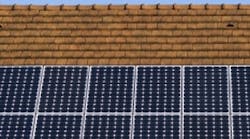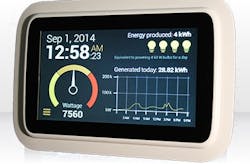Rooftop solar is impacting the machine- and robot-builder OEM market in multiple manners.
Most of what’s reported about solar power concerns large base-station installations, but this type of facility faces limits due to the huge amounts of land required. The highest power density achieved is around 20 W/m2 in desert solar photovoltaic farms, and conventional power plants often have power densities in excess of 1,000 W/m2, writes Robert Wilson in his article, “The Future of Energy: Why Power Density Matters,” on The Energy Collective.
Given the huge amount of land required for solar, it’s no surprise that it generates less than 1% of worldwide power, writes Matt Ridley in his article, “Fossil Fuels Will Save the World (Really),” on The Wall Street Journal online.
But a solution to these land use issues, specifically employing existing rooftop real estate to generate solar power, is at hand. Machine-builder OEMs and the suppliers serving them are addressing the rooftop and other solar markets in response.
“The solar power market contributes up to 50% of our revenue in peak years and accounted for approximately 25% last year,” says Bob Fung, vice president of engineering at Owens Design in Fremont, California. Owens designs and builds automated manufacturing tools for the semiconductor, solar, disk-drive, mobile-electronics and life-science industries. Their systems range from single stand-alone process modules to full turnkey, high-volume production lines.
Also read: Change is in the air
“We work with end manufacturers and OEMs from early concept level to manufacturing and installing custom equipment for production. Our solar customers typically have some type of differentiated technology or process that is not compatible with standard equipment,” adds Fung.
“We believe solar is here to stay, and we will continue to design and build new tools for this market. Much of our business has been productizing advanced technologies, and we see this with our recent customers and with innovation happening in the United States, often in Silicon Valley. We also see some reshoring of solar manufacturing, particularly with vertically integrated companies,” concludes Fung.
Owens Design is helping its customers to build solar photovoltaic cells and panels, and IDEC and Chilicon Power have partnered to bring these products to market as complete systems. Chilicon Power designs and builds rooftop solar systems, and IDEC is distributing these systems in the United States and providing support in terms of quality assurance, financial backing and assurance of longevity.
Like many companies in the rooftop solar industry, Chilicon Power is relatively small and new to the market as the company was formed in 2009. This is a potential problem for its target market of homeowners and small commercial establishments, as both require a 25-year warranty.
Purchasers of solar rooftop systems are demanding and getting 25-year warranties from very small companies formed within the past few years. The potential problem is that purchasers would feel more secure with a warranty from a much bigger company. When a long-term warranty is important to solar rooftop buyers, and it is because payback periods are more than 10 years, they need the company backing the warranty to have a history of more than a few years and sales of more than a few million. Companies such as IDEC can offer that security, which is why its alliance with Chilicon makes sense and may presage more such alliances.
Chilicon calls its Deluxe Monitoring Gateway, but what machine-automation professionals would refer to as an operator interface terminal (OIT).
Image courtesy of Chilicon
For example, Chilicon uses micro instead of string inverters. With a string inverter, a group of about 10 solar panels are connected together and attached to a single inverter. If one of the 10 panels fails or goes into shadow, the output of each of the other nine panels connected to this inverter is reduced to the level of the failed or shadowed panel, greatly reducing total power output from the inverter.
With microinverters, each solar panel has its own. If one of the panels on a rooftop fails or goes into shadow, the rest of the panels are unaffected. Microinverters also allow the power output of each panel to be maximized.
Each of these microinverters is connected via power-line communications to what Chilicon calls its Deluxe Monitoring Gateway, but what machine-automation professionals would refer to as an operator interface terminal (OIT). Like a machine OIT, the gateway connects to the Internet via Wi-Fi or a wired Ethernet connection. And, also like an OIT, remote monitoring is possible from any mobile device such as a smartphone or a tablet, or from a PC at Chilicon headquarters or elsewhere.
The monitoring gateway allows Chilicon to remotely log in, share the screen and train installers in the field—or even complete the software portion of installation after the installers have left the premises. This remote monitoring is particularly important for rooftop solar, as many of the installers are roofers with limited automation expertise.
Homepage image courtesy of dan at FreeDigitalPhotos.net






